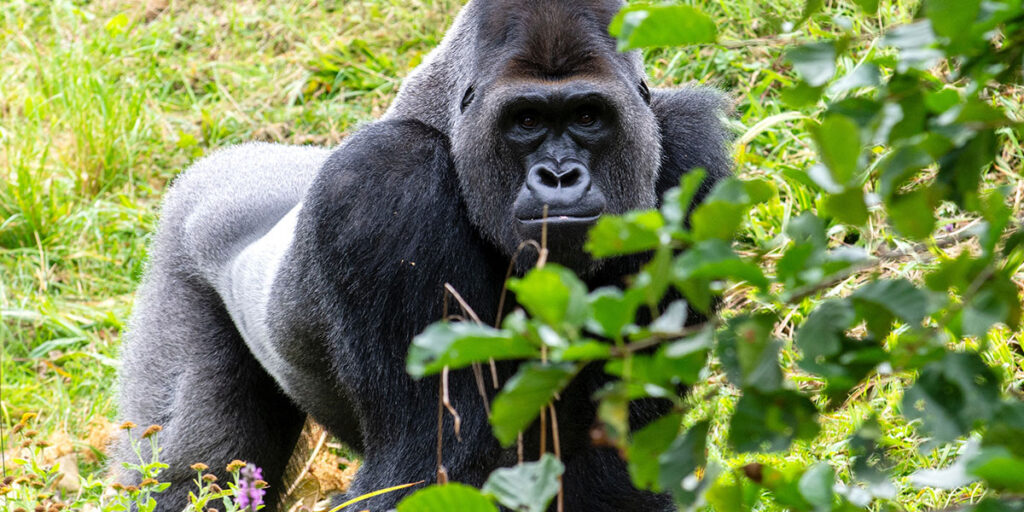Silverback gorilla defense mechanisms and predators
Humans provide the greatest threat to mountain gorillas, as they are ensnared in traps or injured by gunfire. In certain regions, like the Democratic Republic of Congo, mountain gorillas are poached for their flesh, prompting the development of various defense measures.

Defensive strategies of mountain gorillas
Striking their chests.
The initial response of mountain gorillas to fear or significant distress is to pound their chests and stomp their feet while emitting loud vocalizations. This action instills dread in the predator and signals other group or family members to seek shelter. The dominant silverback is responsible for fighting and defending the other family members, occasionally resulting in death. Silverbacks occasionally damage vegetation, thereby intimidating adversaries.
Chest Thumping
Maintaining an upright posture to enhance perceived height and size.
Another intriguing defense tactic employed by mountain gorillas is rising straight to enhance their size and stature, so intimidating potential predators.
Their robust hands.
Mountain gorillas typically possess robust physiques with powerful hands utilized in combat against their predators, particularly leopards. Their hands facilitate movement and assist in lifting or compressing substantial things. The considerable stature of mountain gorillas intimidates their adversaries. The dominant silverbacks typically weigh more than females and are larger than their adversaries—humans and leopards—serving as a protection mechanism.
Exhibiting their prominent canine teeth.
In the presence of a threat, mountain gorillas attack while revealing their formidable canine teeth to intimidate their adversary. Their canine teeth might potentially result in the death of their adversary, particularly if they inflict severe wounds.

Establishing solid relationships around silverbacks.
Similar to fathers in conventional households, dominant silverbacks are regarded as the protectors of their separate gorilla families or groups. Females and infants typically establish robust bonds with silverbacks for protection or in response to threats against infants.
Constantly moving and congregating in groups.
Mountain gorillas protect themselves by consistently residing and traversing in groups. The principle of unity leading to strength and division resulting in failure is applicable to gorilla factions. Mountain gorillas are more adept at combating their shared adversaries, particularly poachers and leopards, when silverbacks collaborate; yet, a solitary silverback is vulnerable to being killed by an opponent.
The population of endangered mountain gorillas is approximately 1,063 individuals, and trekking activities occur in three nations. Uganda provides two gorilla trekking locations, Bwindi Impenetrable and Mgahinga Gorilla National Parks, housing a total of 21 habituated gorilla groups. Additionally, Rwanda features gorilla trekking in Volcanoes National Park, while the Democratic Republic of Congo offers trekking in Virunga National Park, which includes considerations of gorilla defense mechanisms and predators.
Predators of mountain gorillas.
Encountering mountain gorillas in the woods may lead one to believe that these primates are impervious to threats due to their substantial physiques. However, these primates face predators that pose a hazard to them in their native habitat. Mountain gorillas are inherently intellectual, sociable, and emotional. Despite their modest nature, mountain gorillas face significant threats to their survival, and they are among the few species with a low reproductive rate. The following are the foremost predators posing a threat to them.
Humans
Conversely, people have emerged as a threatening component due to their myriad activities. Humans have persistently intruded upon gorilla habitats for numerous reasons, including agriculture, unlawful hunting or poaching, and warfare, resulting in the degradation of these apes’ environments.
Humans pose a hazard to mountain gorillas due to their ability to transmit infectious diseases. These primates are under risk due to their sharing of at least 98% of their genetic DNA with humans. Climate change has emerged as a significant threat to mountain gorilla habitats, primarily due to human activity.
Leopards.
Leopards are the primary predators of mountain gorillas in their natural habitat. Leopards are intelligent carnivores capable of killing an adult mountain gorilla. Their ability to ascend trees complicates the safety of mountain gorillas, even when they attempt to seek refuge in the treetops.
Typically, leopards prey on the juveniles rather than the mature adult silverbacks. However, they are capable of pursuing the Western lowlands.
Crocodilians.
Crocodiles are predators of mountain gorillas. They ambush gorillas near the water’s edge, launching an attack when the animals approach to drink, despite the fact that mountain gorillas seldom consume water. Crocodiles may occasionally ambush gorillas in marshes. Notably, mountain gorillas possess defense capabilities. Upon detecting a predator, mountain gorillas can notify others of the imminent threat. The family members gather around their dominant silverback, whose responsibility is to safeguard them from potential threats.
Defense mechanisms and predators of gorillas
Both females and males can forge robust alliances, enabling them to protect themselves against adversaries. Should the invader refuse to depart, the dominant silverback can confront him. If black backs are present in the gorilla troop, they can guide the others away from predators or even engage the enemy collectively.
Silverback gorilla defense mechanisms and predators, It is essential for all travelers to display a valid gorilla permit when trekking mountain gorillas, and the rates vary. In Uganda, one should allocate approximately US $800 for a gorilla permit, around US $1500 for permits in Rwanda, and about US $450 for permits in the Congo. The age requirement for individuals interested in gorilla trekking is 15 years and older, and permits can be secured through a reputable Uganda safari company.
